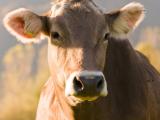Feb 10, 2004 (CIDRAP News) The United States stands by its plan to reopen the border to young Canadian cattle Mar 7 but will keep the border closed to meat from older Canadian cattle, Agriculture Secretary Mike Johanns announced yesterday.
Johanns said he wants to wait until the US Department of Agriculture (USDA) finishes its investigation of recent Canadian cases of bovine spongiform encephalopathy (BSE), or mad cow disease, before deciding whether to allow imports of meat from cattle older than 30 months.
The US border has been closed to all live Canadian cattle and meat from older cattle since Canada's first BSE case was discovered in May 2003. In late December 2004 the USDA announced a plan to allow imports of Canadian cattle younger than 30 months and meat from cattle of any age.
Shortly after that, in early January, Canada reported two more BSE cases. The cases spurred calls from some US groups to continue the import restrictions on Canadian cattle and beef. The USDA said it would investigate the cases in cooperation with Canadian officials, focusing on compliance with the 1997 ban on use of cattle protein in cattle feed.
Johanns said in a statement yesterday, "Our ongoing investigations into the recent finds of BSE in Canada in animals over 30 months are not complete. Therefore, I feel it is prudent to delay the effective date for allowing imports of meat from animals 30 months and over."
Consistency of policy was questioned
He said some have questioned the consistency of allowing importation of meat from older cattle while keeping older live cattle out, because there is evidence that beef from older Canadian cattle has the same risk profile regardless of whether they are slaughtered in Canada or the United States. Because of BSE's long incubation time, the disease is very unlikely to show up in cattle younger than 30 months.
"At the same time, I am asking U.S. officials to move forward in consideration and development of a plan to allow imports of animals 30 months and older for slaughter as well as beef from over 30-month animals as the next step in resuming full trade with Canada," Johanns said.
Johanns' decision drew criticism from western ranchers and others who want the import restrictions to remain, according to the Associated Press. Sen. Tim Johnson, D-S.D., was quoted as saying, "The right course of action would be to scrap this rule entirely until is has been proven that Canada's BSE problems are under control."
The USDA decided to ease the import restrictions after determining that Canada qualifies as a "minimal-risk" region for BSE. Minimal-risk regions are those that may have some BSE cases but have adequate control measures to make it unlikely that cattle or beef from the region would introduce BSE into the United States.
The National Cattlemen's Beef Association (NCBA) welcomed Johanns' decision to maintain the ban on meat from older cattle, saying it matches a recommendation the NCBA made last week. NCBA President Jim McAdams said, "NCBA members remain concerned about certain aspects of this final rule [on easing import restrictions]. However, this is an indication that the USDA is listening to our concerns."
FAO seeks to ease BSE worries
In other developments, the United Nations Food and Agriculture Organization (FAO) said this week that the BSE cases in Canada and the United States and the recent discovery of BSE in a goat in France are "isolated incidents" that "should not cause panic among consumers and producers."
Andrew Speedy, an FAO animal production expert, said western European countries had "significant numbers" of BSE cases in 2001 and 2002, but the disease is declining there now. He cited Switzerland as a country that has successfully fought BSE, reducing cases from 68 in 1995 to 3 in 2004. Switzerland uses a "foolproof" system of cattle identification and registration, a scientific testing program, and preventive measures in the rendering and animal feed industry.
"The goat diagnosed with BSE in France was the first food animal other than cattle to contract the disease naturally," Speedy said. But the goat was born before Europe imposed a total ban on feeding of cattle parts (meat and bone meal, or MBM) to any livestock in 2001, the FAO said.
The United States and Canada banned the use of ruminant animal protein in feed for ruminants in 1997. However, both countries still allow cattle protein in feed for nonruminants such as pigs and poultry. This has caused concern that cattle could be exposed to infective material through cross-contamination in plants that make feed for both cattle and nonruminants or if cattle are given feed intended for nonruminants.
Speedy appeared to suggest that the United States should follow Europe in banning MBM in all livestock feeds. "Cross-contamination can occur in the feed mills, as well as during transport and on the farm," he said. "It was shown in Switzerland that a total ban on MBM was necessary to prevent transmission of infective material."
An alternative safeguard is to completely separate production lines for cattle feed and pig and poultry feed, the FAO said.
Cattle contract BSE by eating feed containing protein from infected animals. It is believed that people contract the human equivalent of BSE, variant Creutzfeldt-Jakob disease, by eating meat products from infected cattle.
See also:
Johanns' statement
http://www.usda.gov/wps/portal/!ut/p/_s.7_0_A/7_0_1OB?contentidonly=true&contentid=2005/02/0047.xml
Dec 30, 2004, CIDRAP News story "US to lift BSE-related ban on Canadian cattle"
http://www.cidrap.umn.edu/cidrap/content/other/bse/news/dec3004beef.html
FAO statement
http://www.fao.org/newsroom/en/news/2005/89641/index.html














